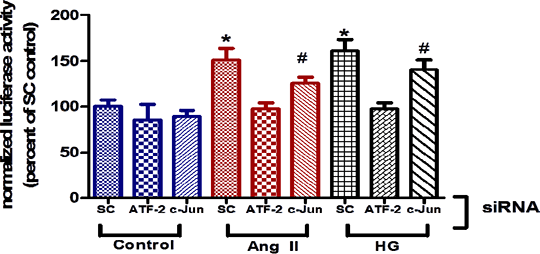High Glucose and Angiotensin II Limit NO Production through a p38 MAPK-AP1 Transcriptional Regulation of Arginase Vascular endothelial dysfunction (VED) is characterized by impaired endothelial cell (EC) production or availability of nitric oxide (NO). NO produced by endothelial NO synthase (NOS) is needed for normal vascular function. During diabetes or hypertension, elevated levels of arginase (ARG) can compete with NOS for available arginine thus reducing vascular NO (3). Diabetes has been linked to elevated ARG and associated with VED (1). In this study we explored transcriptional regulation of increased ARG expression/activity in response to high glucose (HG) in EC. Previously we showed involvement of p38 mitogen activated protein kinase (MAPK) and activating transcription factor-2 (ATF-2) a member of the activator protein-1 (AP1) family in upregulating ARG I in response to angiotensin II (Ang II) (2). Treatment of EC with HG (25 mM, 72 hrs) caused a 55.3±3.1% increase in ARG activity accompanied by a 32.4±5.9% decrease in NO production. We studied involvement of two transcription factors of the AP1 family; ATF- 2 and c-Jun. Depletion of ATF-2 or c-Jun by siRNAs prevented both of the effects of HG on ARG activity and NO production. The use of p38 inhibitor SB-202190 (2 µM) also prevented the HG-induced elevation of ARG activity and restored NO production levels. In addition, HG enhanced ARG I gene transcriptional activity (1.6 folds, p<0.05) measured as luciferase activity in ECs transfected with ARG I promotor luciferase. Transfection of EC with ATF-2 siRNA completely prevented the enhancement of luciferase activity while c-Jun siRNA partially prevented this increase (Figure 1). Treatment of EC with Ang II (0.1 µM, 24 hrs) also enhanced luciferase activity in EC. ATF-2 siRNA prevented this effect and to a lesser extent so did c-Jun siRNA (Figure 1). This indicates that that ATF-2 and c-Jun are necessary for enhanced expression of ARG I under HG conditions or in response to Ang II, both of which are elevated in diabetic conditions. 
Fig. 1: Luciferase activity of ARG 1 promotor in EC treated with Ang II (0.1 µM, 24 hrs) or HG (25mM, 72 hrs), under transfecting conditions of SC; scrambled non targeting siRNA, ATF-2 siRNA or c-Jun siRNA. These and our earlier data indicate that HG and Ang II signal through a common pathway to induce ARG and limit NO. These signaling steps might be therapeutic targets for preventing VED associated with elevated ARG levels. References: (1) Romero MJ, Platt DH, Tawfik HE et al. (2008). Circulation research 102(1): 95-102. (2) Shatanawi A, Alkilany AM, Caldwell RB, Caldwell RW (2011a). Circulation 124(21). (3) Shatanawi A, Romero MJ, Iddings JA et al. (2011b). Am J Physiol Cell Physiol 300(5): C1181-1192.
|


